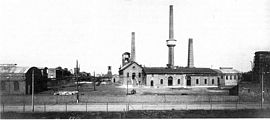Laurweg mine
| Laurweg mine | |||
|---|---|---|---|
| General information about the mine | |||
| Laurweg mine, 1909 | |||
| Mining technology | Underground mining | ||
| Information about the mining company | |||
| Operating company | Eschweiler Mining Association | ||
| End of operation | 1960 | ||
| Successor use | Technology park | ||
| Funded raw materials | |||
| Degradation of | Hard coal | ||
| Geographical location | |||
| Coordinates | 50 ° 49 '43.3 " N , 6 ° 4' 47.5" E | ||
|
|||
| Location | Laurwegstrasse | ||
| local community | Kohlscheid | ||
| country | State of North Rhine-Westphalia | ||
| Country | Germany | ||
The pit Laurweg was a coal mine in Kohlscheid in Aachen area in western North Rhine-Westphalia . The mine was initially operated by the Association for Hard Coal Construction in the Wurmrevier and from 1907 by the Eschweiler Mining Association EBV. Production was stopped in 1955 after Laurweg was merged with the neighboring Gouley mine as a composite mine.
history
The Laurweg pit, which was one of the oldest pits in the worm area, was first mentioned in 1612. In 1814, the first seigere shaft was sunk on Laurweg . From 1840, the mine, which was merged with neighboring pits in various associations in the following decades, belonged to the association society. This merged with the EBV in 1907.
In 1912, the underground network with the neighboring Voccart mine was established, which meant that independent production was no longer required. In 1914 coal production from the Kämpchen mine was relocated to the Laurweg mine . The Frankschacht was expanded as the main shaft .
After heavy fighting during the Second World War was from the pit Laurweg to pit Gouley in neighboring Wuerselen a Strombehelfskabel relocated to the drainage to ensure the second named. In 1950 it was merged with the Gouley mine to form the Gouley-Laurweg composite mine and connected via a blind shaft with a diameter of 4.20 m between the 455 m level of Laurweg and the 650 m level of Gouley . Both mines produced anthracite . Until 1955, the mined coal was also extracted on Laurweg, then this task was completely taken over by the expanded Gouley mine. Laurweg served for another five years for staff trips until the extended wash house on Gouley went into operation. The miners who were no longer needed on Laurweg were deployed in other EBV pits.
In 1976 the station building of the Kohlscheid train station was demolished and the Laurweg briquette factory was stopped. Then the Kohlscheid freight yard and the connecting railway to the Laurweg mine were dismantled.
Reuse
On the former colliery site of the mine there is now a technology park , in which the mobile phone company Ericsson is also based, which uses the existing mine house of the Laurweg colliery as an administration building. Like most of the daytime facilities , the washrooms and the magazine were demolished and replaced by new buildings. The former track system next to the colliery, the laundrette and the warehouse is now a parking lot. The Casino Laurweg later became a (now closed) restaurant.
Heap
The Wilsberg mining dump was created from the mountains of the pit, allowing a wide view of the landscape.
literature
Aretz, Josef: Kohlscheider Bergwerke.- Herzogenrath 1986
Web links
- Digitized historical plans of the Laurweg mine of the DigiPEER project (digitization of valuable plans and technical drawings to record and develop the space in the 20th century)
- »Grube Laurweg« Amateur film digitized by WDR about work on the Laurweg mine in 1959.
Individual evidence
- ↑ Matthias Kaever: The non-renewable energy sources between Rur and Maas . LIT Verlag, Münster 2004, ISBN 978-3825874247 , p. 192
- ↑ [1] Herzogenrath Technology Park
- ↑ [2] Overview plan of the pit on DigiPEER
- ↑ View from the Wilsberg mine dump to the northeast of the technology park and the Alsdorf dump


